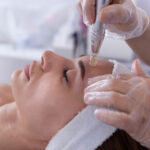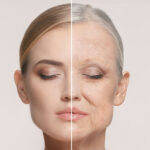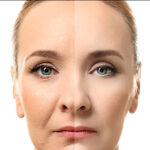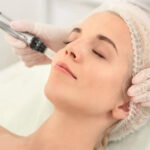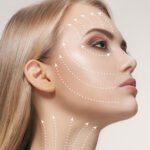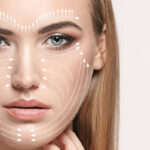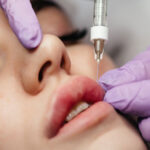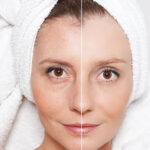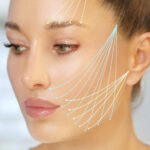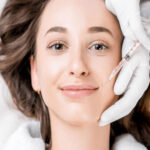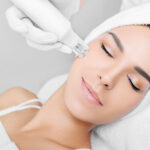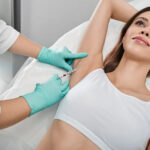Burtom ‣ Departments ‣ Dermatology
Language: 🇬🇧 English | 🇹🇷 Türkçe

Dermatology Department Overview

The Dermatology Department serves as a specialized medical center dedicated to the intricate realm of skin health, hair, and nail care. In this comprehensive domain, skilled dermatologists employ a multifaceted approach encompassing medical, surgical, and cosmetic dermatology.
Medical dermatology involves the diagnosis and treatment of diverse skin conditions, ranging from common afflictions like acne to complex autoimmune disorders. Surgical interventions, conducted with precision, address issues such as skin cancers, moles, and growths. The department extends its expertise to cosmetic dermatology, offering aesthetic procedures like Botox, fillers, and laser therapy.
Pediatric dermatology focuses on specialized care for young patients dealing with congenital skin conditions and childhood dermatological issues. Dermatologists also attend to disorders affecting hair and nails, ranging from alopecia to fungal infections.
Preventive care takes center stage with routine skin cancer screenings, emphasizing early detection for optimal treatment outcomes. Additionally, the department may utilize innovative services like phototherapy for conditions such as psoriasis and offer patch testing to identify contact allergies.
Embracing technological advancements, some dermatology departments provide tele-dermatology services, facilitating remote consultations for specific cases. Patient education is integral, with dermatologists guiding individuals on proper skincare practices, sun protection, and lifestyle modifications.
Beyond immediate clinical care, dermatology departments contribute to clinical research, advancing dermatological knowledge and fostering the development of innovative treatments.
In essence, the Dermatology Department adopts a holistic approach, recognizing the interconnectedness of skin health with overall well-being. Dermatologists collaborate with patients to tailor individualized treatment plans, considering medical necessities, cosmetic aspirations, and the long-term health of the skin. This comprehensive care approach underscores the department’s commitment to enhancing and maintaining the health, appearance, and vitality of the skin.
Key Functions of an Dermatology

The key functions of a Dermatology Department encompass a wide range of services aimed at promoting skin health, diagnosing and treating dermatological conditions, and addressing cosmetic concerns. Here are the essential functions:
Medical Dermatology: Diagnosing and treating various skin conditions, including dermatitis, psoriasis, acne, and autoimmune disorders.
Surgical Dermatology: Performing surgical procedures for the removal of skin cancers, moles, and other skin growths, with a focus on precision and reconstruction.
Cosmetic Dermatology: Offering cosmetic procedures such as Botox, fillers, laser therapy, and chemical peels to address aging, pigmentation, and texture concerns.
Pediatric Dermatology: Providing specialized care for pediatric patients with congenital skin conditions, birthmarks, and childhood dermatological issues.
Hair and Nail Disorders Management: Diagnosing and treating disorders affecting the hair and nails, including alopecia, fungal infections, and ingrown toenails.
Skin Cancer Screenings: Conducting routine screenings for early detection of skin cancers, emphasizing preventive care.
Phototherapy Services: Utilizing controlled UV light exposure for conditions like psoriasis and eczema as part of treatment.
Patch Testing for Allergies: Identifying contact allergies through patch testing, a crucial service for patients with allergic dermatitis.
Tele-Dermatology: Providing remote consultations through tele-dermatology services, enhancing accessibility to dermatological care.
Patient Education: Offering guidance on proper skincare practices, sun protection, and lifestyle modifications to manage and prevent dermatological conditions.
Clinical Research: Engaging in clinical research to advance dermatological knowledge, contributing to innovative treatments and approaches.
Holistic Care Approach: Recognizing the interconnectedness of skin health with overall well-being, dermatologists collaborate with patients to tailor individualized treatment plans.
Emergency Dermatology Care: Providing emergency care for acute dermatological issues or urgent situations, ensuring prompt intervention when needed.
Telehealth Services: Offering remote healthcare services for follow-up appointments and consultations, enhancing accessibility to ongoing care.
Continuing Medical Education: Ensuring that healthcare professionals stay updated on the latest developments in dermatology through continuous education and training.
These key functions collectively contribute to the Dermatology Department’s overarching goal—to provide comprehensive and specialized care for the skin, hair, and nails, addressing medical needs, cosmetic goals, and overall skin health.
Situations within the scope of Dermatology

Situations within the scope of Dermatology cover a diverse array of skin, hair, and nail conditions. Dermatologists are equipped to address various scenarios, including:
Acne Management:Diagnosing and treating acne, providing personalized skincare regimens and, if necessary, prescription medications.
Skin Cancer Diagnosis and Treatment:Conducting screenings, biopsies, and surgical interventions for the removal of skin cancers, such as basal cell carcinoma, squamous cell carcinoma, and melanoma.
Eczema and Dermatitis Care: Managing chronic conditions like eczema and dermatitis through medication, lifestyle modifications, and skincare routines.
Psoriasis Treatment: Providing treatment plans for psoriasis, including topical medications, phototherapy, and systemic medications when needed.
Mole and Skin Growth Evaluations: Assessing moles and other skin growths for signs of malignancy, performing biopsies or excisions when necessary.
Hair Loss Evaluation: Investigating and addressing hair loss conditions such as alopecia, offering therapeutic interventions and lifestyle recommendations.
Nail Disorders Management: Diagnosing and treating nail disorders, including fungal infections, ingrown nails, and other abnormalities.
Allergic Reactions and Contact Dermatitis: Identifying and managing allergic reactions and contact dermatitis through patch testing and avoidance strategies.
Cosmetic Procedures: Conducting cosmetic procedures to address aesthetic concerns, including Botox, fillers, laser therapy, and chemical peels.
Pediatric Dermatology: Providing specialized care for children with skin conditions, birthmarks, and genetic dermatological disorders.
Chronic Skin Conditions: Managing chronic skin conditions such as rosacea, vitiligo, and lupus, tailoring treatment plans for individual patient needs.
Infectious Skin Conditions: Diagnosing and treating infectious skin conditions, including bacterial, viral, and fungal infections.
Skin Rejuvenation: Offering treatments for skin rejuvenation, addressing issues like fine lines, wrinkles, and sun damage.
Skin Discoloration and Pigmentation Disorders: Evaluating and managing conditions affecting skin color, including hyperpigmentation and hypopigmentation.
Tele-Dermatology Consultations: Conducting remote consultations for specific dermatological concerns, enhancing accessibility to expert care.
These situations showcase the breadth of dermatological expertise, emphasizing the role of dermatologists in addressing a wide range of skin-related issues and promoting overall skin health.
Patient Experience in the Dermatology

The patient experience in Dermatology revolves around providing comprehensive, compassionate care for individuals dealing with various skin, hair, and nail concerns. Here are key aspects that contribute to a positive patient experience in Dermatology:
Accessible Appointments:Ensuring timely access to appointments for both urgent and routine dermatological concerns, minimizing wait times.
Welcoming Environment:Creating a comfortable and welcoming atmosphere within the clinic or dermatology practice to ease patient anxiety.
Effective Communication:Establishing clear and empathetic communication between dermatologists and patients, fostering trust and understanding.
Thorough Skin Examinations:Conducting thorough skin examinations, addressing patient concerns, and explaining the diagnostic process.
Education and Information Sharing:Providing patient education on skin conditions, treatment options, and preventive measures to empower informed decision-making.
Individualized Treatment Plans:Developing personalized treatment plans that consider the unique needs, preferences, and lifestyle of each patient.
Minimizing Discomfort:Minimizing discomfort during procedures and treatments through effective pain management and communication.
Cosmetic Consultations:Conducting thorough cosmetic consultations, discussing goals and expectations for aesthetic procedures, and ensuring realistic outcomes.
Pediatric-Friendly Approach:Adopting a pediatric-friendly approach for younger patients, creating a reassuring environment for children dealing with dermatological issues.
Follow-up Care:Providing clear instructions for follow-up care and ensuring accessibility for any post-appointment questions or concerns.
Respect for Patient Privacy:Maintaining patient privacy and confidentiality during consultations, examinations, and treatments.
Transparent Billing and Insurance Processes:Clearly communicating billing information and insurance processes to minimize financial concerns and uncertainties.
Dermatologist-Patient Partnership:Fostering a collaborative partnership between dermatologists and patients, where patients feel actively involved in their care.
Patient Advocacy:Acting as advocates for patients, addressing their concerns, and ensuring that their voices are heard throughout the healthcare journey.
Tele-Dermatology Accessibility:Offering tele-dermatology services for remote consultations, providing accessibility and continuity of care.
By prioritizing accessibility, communication, individualized care, and a patient-centric approach, Dermatology aims to create a positive and supportive experience for individuals seeking solutions to their skin health concerns. The emphasis on education and collaboration contributes to patients feeling empowered and confident in their dermatological care.
Conclusion

In conclusion, the patient experience in Dermatology is characterized by a commitment to holistic and patient-centered care, addressing a myriad of skin, hair, and nail concerns. Dermatologists play a crucial role in fostering positive interactions and outcomes for individuals seeking solutions to dermatological issues.
The emphasis on accessible appointments, welcoming environments, and effective communication establishes a foundation of trust and comfort. Thorough skin examinations, coupled with patient education, ensure that individuals are well-informed about their conditions and treatment options. Dermatologists strive to create individualized treatment plans that consider the unique needs and preferences of each patient, promoting a sense of empowerment in decision-making.
For cosmetic consultations, a transparent and collaborative approach is taken, setting realistic expectations and ensuring patient satisfaction with aesthetic procedures. In pediatric dermatology, a child-friendly environment and approach contribute to the well-being of younger patients and their families.
The commitment to follow-up care, respect for patient privacy, and transparent billing processes further enhance the overall patient experience. In embracing tele-dermatology, Dermatology extends accessibility, ensuring that patients can receive expert care remotely.
Ultimately, the Dermatology field’s dedication to advocacy, partnership, and a patient-centric ethos reflects the overarching goal of promoting skin health and well-being. Through these efforts, Dermatology strives to not only address dermatological concerns but also enhance the overall quality of life for individuals, fostering confidence and satisfaction in their skin health journey.
Medical Devices Used in the Dermatology

Dermatology utilizes various medical devices for diagnostic, therapeutic, and cosmetic purposes. Here are some common medical devices employed in Dermatology:
Dermatoscope: Used for magnified visualization of skin lesions, aiding in the diagnosis of skin conditions and skin cancer.
Cryotherapy Devices: Utilized for freezing and removing skin lesions, such as warts or precancerous growths, using liquid nitrogen.
Laser Devices: Different lasers target various skin concerns, including vascular lesions, pigmentation issues, and hair removal.
Microdermabrasion Machines: Employed for exfoliating the skin’s outer layer, promoting skin renewal and addressing issues like fine lines and acne scars.
Light Therapy Devices: Includes devices for photodynamic therapy (PDT) and intense pulsed light (IPL) treatments to address various skin conditions.
Electrosurgical Units: Used for cutting or coagulating tissues during dermatological surgeries, including mole removal or skin cancer excisions.
Skin Biopsy Punches: Instruments for obtaining skin tissue samples for pathological examination to diagnose skin conditions.
Ultrasound Devices: Employed for imaging deeper skin layers, assisting in the assessment of skin lesions and guiding certain procedures.
Mohs Micrographic Surgery Equipment: Specialized instruments used in Mohs surgery, a precise technique for removing skin cancers layer by layer.
Topical Anesthetic Devices: Devices for applying topical anesthetics to numb the skin before dermatological procedures.
Dermal Fillers and Injectables: Used for cosmetic purposes to address wrinkles, lines, and volume loss in the skin.
Skin Staplers: Utilized in dermatological surgeries for closing incisions with staples instead of sutures.
Ultrasonic Skin Tightening Devices: Devices that use ultrasound technology to tighten and lift the skin, reducing sagging and improving skin tone.
Electrocautery Devices: Used to cut or coagulate tissues by applying an electric current, often used in the removal of benign skin growths.
Fractional Laser Devices: Used for fractional laser resurfacing, targeting specific areas of the skin to improve texture and reduce imperfections.
Skin Imaging Systems: Utilized for documenting and analyzing skin conditions over time, aiding in monitoring treatment progress.
These medical devices contribute to the diverse range of dermatological services, encompassing diagnostic procedures, surgical interventions, and various cosmetic treatments. Dermatologists leverage these technologies to provide specialized and effective care tailored to individual patient needs.
Doctors and Medical Staff

Areas of interest

Get a Free Second Opinion
Experienced Burtom Medical Team is Ready to Help

I consent to Burtom Health Group using my aforesaid personal data for the purposes described in this notice and understand that I can withdraw my consent at any time by sending a request to info@burtom.com.


